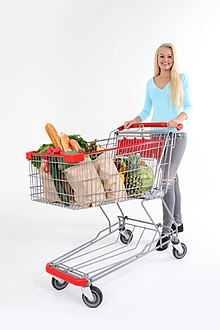
A shopping cart (American English), trolley (British English, Australian English), or buggy (Southern American English, Appalachian English), also known by a variety of other names, is a wheeled cart supplied by a shop or store, especially supermarkets, for use by customers inside the premises for transport of merchandise as they move around the premises, while shopping, prior to heading to the checkout counter, cashiers or tills. Increasing the amount of goods a shopper can collect increases the quantities they are likely to purchase in a single trip, boosting store profitability.
In many cases, customers can then also use the cart to transport their purchased goods to their vehicles. However, some carts are designed to prevent them from leaving either the store or the designated parking area by magnetically locking the wheels. In many places in the United States, Canada and the United Kingdom, customers are encouraged to leave the carts in designated areas within the parking lot, and store employees will return the carts to the entrances. In some areas, carts are connected by locking mechanisms that require the insertion of a coin or token to release an individual cart. Returning the cart to its designated area releases the coin to the customer.
Design

Most modern shopping carts are made of metal or a combination of metal and plastic and have been designed to nest within each other in a line to facilitate collecting and moving many at one time and also to save on storage space. The carts can come in many sizes, with larger ones able to carry a child. There are also specialized carts designed for two children, and electric mobility scooters with baskets designed for individuals with disabilities.
As of 2006, approximately 24,000 children are injured in the United States each year in shopping carts. Some stores both in the U.S. and internationally have child carrying carts that look like a car or van with a seat where a child can sit equipped with a steering wheel and sometimes a horn. Such "Car-Carts" may offer protection and convenience by keeping the child restrained, lower to the ground, protected from falling items, and amused.
Shopping carts are usually fitted with four wheels, however if any one wheel jams the cart can become difficult to handle. Most carts in the United States have swivel wheels at the front, while the rear wheels are fixed in orientation, while in Europe it is more common to have four swivel wheels. This difference in design correlates with smaller retail premises in Europe. The front part of the cart is often sectioned off in order to place household goods such as bleach, cleaning products etc. so that they do not mix with edible products.
An alternative to the shopping cart is a small hand-held shopping basket. A customer may prefer a basket for a small amount of merchandise. Small shops, where carts would be impractical, often supply only baskets, or may offer a small cart which uses an inserted shopping basket within the frame of the cart to provide either choice to a customer.
History
Development of first shopping cart by Sylvan Goldman
One of the first shopping carts was introduced on June 4, 1937, the invention of Sylvan Goldman, owner of the Humpty Dumpty supermarket chain in Oklahoma. One night, in 1936, Goldman sat in his office wondering how customers might move more groceries. He found a wooden folding chair and put a basket on the seat and wheels on the legs. Goldman and one of his employees, a mechanic named Fred Young, began tinkering. Their first shopping cart was a metal frame that held two wire baskets. Since they were inspired by the folding chair, Goldman called his carts "folding basket carriers". Another mechanic, Arthur Kosted, developed a method to mass-produce the carts by inventing an assembly line capable of forming and welding the wire. The cart was awarded patent number 2,196,914 on April 9, 1940 (Filing date: March 14, 1938), titled, "Folding Basket Carriage for Self-Service Stores". They advertised the invention as part of a new "No Basket Carrying Plan". Goldman had already pioneered self-serve stores and carts were part of the self-serve retail concept.
The invention did not catch on immediately. Men found them effeminate; women found them suggestive of a baby carriage. "I've pushed my last baby," an offended woman informed Goldman. After hiring several male and female models to push his new invention around his store and demonstrate their utility, as well as greeters to explain their use, shopping carts became extremely popular and Goldman became a multimillionaire. In urban areas like New York City, where transporting groceries home from the store's parking lot is more likely to involve walking and/or a trip by public transportation than a car ride, privately owned carts resembling Goldman's design are still popular. Instead of baskets, these carts are built to hold the paper bags dispensed by the grocery store.
Another shopping cart innovator was Orla Watson, who invented the swinging rear door to allow for "nesting" in 1946. Orla Watson continued to make modifications to his original design. Advice from his trusted business partners Fred Taylor, a grocery store owner in Kansas City, and George O'Donnell, a grocery store refrigeration salesman, and the incorporation of Watson's swinging door yielded the familiar nesting cart that we see today using the "double-decker" approach. Goldman patented a similar version of the cart with only one basket rather than the double-decker feature, which he called the "Nest-Kart" in 1948, over one year after Watson filed for his patent. The Nest-Kart incorporated the same nesting mechanism present on the shopping carts designed by Watson, and an interference investigation was ordered by Telescope Carts, Inc. alleging infringement of the patent in 1948. After a protracted legal battle, Goldman ultimately recognized Watson's invention and paid one dollar in damages for counterfeit, in exchange for which Watson granted Goldman an exclusive operating license (apart from the three licenses that had already been granted).
In 1909, Bessie DeCamp invented a seat belt for chairs, go-carts or carriages. This was well before shopping carts with child seating areas were invented. Goldman introduced a child seating area on shopping carts in 1947. For whatever reason, it wasn't until 1967 that seat belts for shopping carts were introduced by David Allen. It was high tech for the time, because it was a retractable seat belt.
Development of nesting carts by Orla Watson
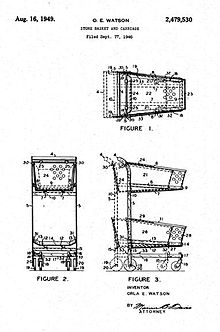
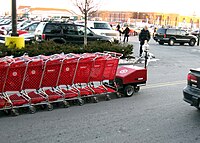
In 1946, Orla Watson devised a system for a telescoping (i.e., "nesting") shopping cart which did not require assembly or disassembly of its parts before and after use like Goldman's cart; Goldman's design up until this point required that the cart be unfolded much like a folding chair. This cart could be fitted into another cart for compact storage via a swinging one-way rear door. The swinging rear door formed the basis of the patent claim, and was a major innovation in the evolution of the modern shopping cart. Watson applied for a patent on his shopping cart invention in 1946, but Goldman contested it and filed an application for a similar patent with the swinging door feature on a shopping cart with only one basket in 1948 which Goldman named the "Nest-Kart". After considerable litigation and allegations of patent infringement, Goldman relinquished his rights to the patent in 1949 to Watson and his company, Telescope Carts, Inc. realizing that the swinging rear door feature was the key to Watson's patent. Watson was awarded patent #2,479,530 on August 16, 1949. In exchange, Goldman was granted an exclusive licensing right in addition to the three other licenses previously granted; Telescope Carts, Inc. continued to receive royalties for each cart produced by Goldman's company that incorporated the "nesting" design. This included any shopping cart utilizing his hinged rear door, including the familiar single basket "nesting" designs similar to those used in the present.
Owing to its overwhelming success, many different manufacturers desired to produce shopping carts with the rear swinging door feature but were denied due to the exclusive license issued to Goldman. The federal government filed a lawsuit against Telescope Carts, Inc. in 1950 alleging the exclusive license granted to Goldman was invalid, and a Consent Decree was entered into where Telescope Carts, Inc. agreed to offer the same license to any manufacturer. Orla Watson and Telescope Carts, Inc. licensed their telescoping shopping cart design to several manufacturers throughout the 1950s and 1960s until the patent expired.
New developments

In 2012, a driverless shopping cart was made by Chaotic Moon Labs. The device, called "Project Sk8" or "Smarter Cart" was basically a cart fitted with Windows Kinect (to detect obstacles), and an electric drivetrain, and used in conjunction with a Windows 8 tablet. For smaller stores, shopping baskets with wheels can be used either as a large basket or a small cart. These carts are designed for indoor use only.
In 2017, a mobile device shelf was added to shopping carts at Target stores to support the digital in-store shopping experience. The shelf was invented and designed by Nick Dyer, a former employee of Target. The introduction of "EASY Shopper" in 2019 by Pentland Firth Software GmbH in partnership with the German retailer EDEKA represents another step in the evolution of shopping carts. Equipped with a tablet, barcode scanner, and cashierless checkout system, the smart shopping cart aims to provide customers with a more streamlined and convenient shopping experience. The system utilizes computer vision to accurately track items in the cart and allow customers to scan and pay for their purchases as they shop, reducing the need to stand in line and wait to pay for their items.
Retail store acceptance
Past studies determined that retailers who did not offer shopping carts such as Sears suffered lower sales in comparison to retailers who did use shopping carts. Subsequent to the introduction of shopping carts and centralized checkout lines at Sears stores, the company noticed a correlating increase in sales.
In 2004, British supermarket chain Tesco trialed shopping carts with user-adjustable wheel resistance, heart rate monitoring and calorie counting hardware in an effort to raise awareness of health issues. The cart's introduction coincided with Tesco's sponsorship of Cancer Research UK's fundraising event Race for Life.
Also in 2004, shopping carts were identified as a source of pathogens and became a major public health concern. This was primarily due to the media spotlight on a Japanese research study revealing large amounts of bacteria on shopping carts. Those findings were later backed by a University of Arizona study in 2007.
In 2009, researchers developed prototypes of computerized context aware shopping carts by attaching tablet computers to ordinary carts. Initial field trials showed that the prototype's context awareness provided an opportunity for enhancing and altering the shopping experience.
Some retailers, such as Target, have begun using carts fully made of recycled plastic with the only metal part being the wheel axles, drawing away from the established metal cart design. Target's cart has won design awards for its improved casters, interchangeable plastic parts to simplify repairs, and handles that improve maneuverability. Other cart designs also incorporate additional features such as a cup holder for cold or hot drinks or a bouquet of flowers, along with other features such as a secure shelf for a tablet computer or mobile phone to allow the use of mobile coupons and circulars, or as seen in an all-plastic design created for the Wisconsin-based Festival Foods and also used by Whole Foods Market by Bemis Manufacturing Company, all of these features, along with extra rungs on the side rail designed to attach plastic bags or carry handles for beverages. Smaller half-sized carts for smaller shopping trips have also become common.
Deposits


In many countries, the customer has to make a small deposit by inserting a coin, token or card, which is returned if and when the customer returns the cart to a designated cart parking point. The system works through a lock mounted on the handle of the cart, connecting it to a chain mounted on the cart in front of it when nested together, or to a chain mounted on a cart collection corral. Inserting the token unlocks the chain, and reinserting the chain locks it in place and ejects the token for user to retrieve.
One motivation behind the deposit system is to reduce the expense of employees having to gather carts that are not returned, and to avoid damage done by runaway carts. Another benefit is that carts are less likely to be removed from the store premises and abandoned in the surrounding neighborhood. Carts that are not returned may be returned voluntarily by a pedestrian, with the deposit coin acting as a reward.
Although almost ubiquitous in continental Europe and the UK, the deposit system is less common in Canada and has not been widely adopted in the United States, with the exception of some chains like ALDI, which require a $0.25 deposit. One of the first store chains to use the $0.25 deposit system in the US was the Real Superstore (a subsidiary of National Supermarkets) in the early 1990s. Other stores such as Costco and ShopRite also use the coin deposit system, but it is not used at all of their locations.
In Australia, deposit systems are common in some local government areas, as they have been made compulsory by local law. Usually, all ALDI stores, and most Coles and Woolworths stores will have a lock mechanism on their carts that requires a $1 or $2 coin to unlock.
The deposit varies, but usually coins of higher value, such as €1, £1, or $1 are used. While the deposit systems usually are designed to accommodate a certain size of domestic coin, foreign coins, former currencies (like German D-Marks), or even appropriately folded pieces of cardboard can be used to unlock the carts as well. Cart collectors are also usually provided with a special key that they can use to unlock the carts from the cart bay and get the key back.
Some retailers sell "tokens" as an alternative to coins, often for charity. Merchandising companies also offer branded shopping tokens as a product.
Theft prevention
Shopping cart theft can be a costly problem with stores that use them. The carts, which typically cost between $75 and $150 each, with some models costing $300–400, are removed by people for various purposes. To prevent theft, estimated at $800 million worldwide per annum, stores use various security systems as discussed below.
Cart retrieval service
Most retailers in North America utilize a cart retrieval service, which collects carts found off the store's premises and returns them to the store for a fee. The primary strength of this system is the ability of pedestrian customers to take purchases home and allow retailers to recapture abandoned carts in a timely manner at a fraction of the cost of a replacement cart. It also allows retailers to maintain their cart inventories without an expensive capital outlay. A drawback of this method is that it is reactive, instead of proactively preventing the carts from leaving the store premises.
Electronic and magnetic
Electronic systems are sometimes used by retailers. Each shopping cart is fitted with an electronic locking wheel clamp, or "boot". A transmitter with a thin wire is placed around the perimeter of the parking lot, and the boot locks when the cart leaves the designated area. Store personnel must then deactivate the lock with a handheld remote control to return the cart to stock. Often, a line is painted in front of the broadcast range to warn customers that their cart will stop when rolled past the line. However, these systems are very expensive to install and although helpful, are not foolproof. The wheels can be lifted over the electronic barrier and/or pushed hard enough that the locks break. There are also safety concerns if the person pushing the trolley is running, and also if the trolley doesn't lock and is taken onto a road, locking due to magnetic materials under the road. Some cities have required retailers to install locking wheel systems on their shopping carts. In some cases, electronic systems companies have encouraged passage of such laws to create a captive audience of potential customers.
Physical
A low-tech form of theft prevention utilizes a physical impediment, such as vertical posts at the store entrance to keep carts from being taken into the parking lot. This method also impedes physically disabled customers, which may be illegal in many jurisdictions. For example, in the United States it would be a violation of the Americans with Disabilities Act of 1990.
Another method (used for example by UK supermarket Iceland) is to mount a pole taller than the entrance, onto the shopping cart, so that the pole will block exit of the cart. However, this method requires that the store aisles be higher than the pole, including lights, piping, any overhead signage and fixtures. It also prevents customers from carting their purchases to their cars in the store's carts. Many customers learn to bring their own folding or otherwise collapsible cart with them, which they can usually hang on the store's cart while shopping.
A further system is to use a cattle grid style system. All pedestrian exits have specially designed flooring tiles, which, along with specially designed wheels on the cart, will immobilize the cart as they roll onto them. Like the magnetic systems, this can easily be overcome by lifting the cart over the tiles.
Name

The names of shopping carts vary by region. The following names are region-specific names for shopping carts. Many of these names may be used alone or in descriptive phrases such as grocery ____, shopping ____, or supermarket ____ for disambiguation:
- cart or basket – the United States, Canada and the Philippines
- buggy – used by some in Southeast Michigan, Western Pennsylvania (where it is considered part of the region's dialect), the Southern United States and certain parts of Canada
- trolley – the United Kingdom, Ireland, Australia, New Zealand, Malaysia, Trinidad and Tobago, South Africa and some regions of Canada. Was also formerly used in the Philippines
- carriage – used by some in the New England region of the United States
- barrae or coohudder – some places in Scotland
- bascart – various regions
- wagon – New York, Hawaii
- trundler – some places in New Zealand
- wheelbasket – some places in the Eastern United States, notably Western Massachusetts
For disabled people

Special electronic shopping carts are provided by many retailers for the elderly or disabled people. These are essentially electric wheelchairs with an attached basket. They allow customers to navigate around the store and collect items.
Manually powered carts are also available specifically designed for use by wheelchair users. A still-to-be-implemented aid for people with disabilities is the addition of a guide wheel at the center of rotation of a cart with four caster wheels. In order to allow the nesting of carts to be unhindered, this guide wheel is attached to the front of the cart with a piece of spring steel which bends under the cart's weight.
Caroline's Carts are designed for aiding non-ambulatory adults or larger children, but require an additional person to push.
Conceptual detours of the shopping cart in art, design and consumerism
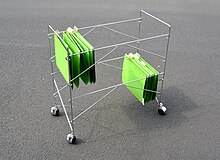

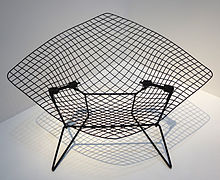
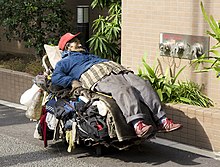
Shopping cart manufacturers such as Caddie, Wanzl, or Brüder Siegel maintained intensive direct and indirect mutual business relations with artists, graphic designers, industrial and furniture designers such as Charles Eames, Harry Bertoia, or Verner Panton since the market launch of the shopping cart - not only for new and further developments of their own shopping carts and wire basket goods, but also for advertising and PR purposes. Olivier Mourgue, Otl Aicher, Stiletto [fr] as well as other artists and designers had wire furniture or artwork made by shopping cart manufacturers.
One of the most famous thematizations of a shopping cart in art is the 1970 sculpture "Supermarket Lady" by US pop artist Duane Hanson, which is critical of consumerism.
In 1983, the neoist "one-man artist group" Stiletto Studios, from Berlin converted a 'stray' shopping cart into an 'inverted' cantilever-wire chair on the principle of objet trouvé. As a design simulation critical of consumer culture, Stiletto's ironically titled "Consumer's Rest" Lounge Chair recurred to the fact that Eames' and Bertoia's wire furniture were already over-aestheticized adaptations of the contemporary advent of shopping carts in the United States, and thus were themselves already recursions to the consumer revolutionary context of the International Style in architecture and design.
By far, most stolen shopping carts that are not returned and left outside their location, however, are misappropriated by occasional subsequent and secondary users without any artistic or cultural-critical readymade intentions as emergency solutions. Other uses of shopping carts include improvised pieces of furniture (for example, as laundry baskets), or universal nomadic furniture for the household goods of the homeless, or, ignoring the fact that the zinc and plastic coatings of the wire surfaces are harmful to health when heated, as ad hoc barbecue grills.
See also
References
- "Definition of SHOPPING CART". www.merriam-webster.com. Retrieved March 7, 2023.
- Gary A. Smith, MD, DrPH (2006). "Shopping Cart–Related Injuries to Children". Pediatrics. American Academy of Pediatrics. Retrieved June 20, 2012.
{{cite web}}: CS1 maint: multiple names: authors list (link) - "Sylvan Goldman: Fascinating facts about Sylvan Goldman inventor of the shopping cart in 1937". The Great Idea Finder. April 24, 2007. Archived from the original on December 21, 2017. Retrieved June 20, 2012.
- Crockett, Zachary (February 18, 2016). "How a Basket on Wheels Revolutionized Grocery Shopping". Priceconomics. Retrieved March 8, 2016.
- "Goldman, Sylvan N. | 1971". oklahomahof.com. Retrieved May 12, 2023.
- Orla Watson Invented the Grocery Cart with a Basket. November 16, 2003. American Profile.
- Terry P. Wilson, The Cart that Changed the World: The Career of Sylvan N. Goldman (University of Oklahoma Press, 1978). ISBN 978-0-8061-1496-5
- Catherine Grandclément, "Wheeling One's Groceries Around the Store: The Invention of the Shopping Cart, 1936-1953", in Warren Belasco and Roger Horowitz (eds.), Food Chains: From Farmyard to Shopping Cart (University of Pennsylvania Press, 2008), pp. 233-251. ISBN 978-0-8122-4128-0
- Ted Morgan, On Becoming American: A Celebration of What it Means and How it Feels (Boston: Houghton Mifflin, 1978, pp. 45-6). ISBN 978-0-395-26283-2
- ^ Catherine Grandclément (2006). Wheeling food products around the store… and away: the invention of the shopping cart, 1936-1953 . CSI Working Papers Series.
- Smithsonian Snapshot: Telescoping Shopping Cart, c. 1949. Newswise.com.
- Child's-chair safety device - Bessie DeCamp - patent #944,020
- "Unarco--Cart History". Retrieved March 31, 2016.
- Phil Ament. "Inventor Sylvan Goldman Biography". Ideafinder.com. Archived from the original on December 21, 2017. Retrieved March 31, 2016.
- Safety retaining belt for shopping carts – David L. Allen – patent #3,550,136
- "ArchPatent". ArchPatent. Retrieved April 7, 2013.
- Jeanne Sklar. "Technology, Invention, and Innovation collections". Amhistory.si.edu. Archived from the original on October 12, 2018. Retrieved April 7, 2013.
- "Microsoft Kinect Games Grocery Shopping at Texas Whole Foods". WIRED. February 27, 2012. Retrieved March 31, 2016.
- US9637152B2, Dyer, Nicholas John & Abel, Stacy Lee, "Support shelf for a shopping cart and associated shopping assembly", issued 2017-05-02
- Warentest, Stiftung (April 17, 2020). "Einkaufs-App Edeka Easy Shopper im Schnelltest: Keine Hektik an der Kasse mehr". www.test.de (in German). Retrieved February 13, 2023.
- Martin, Cristina (January 16, 2023). "Smart shopping trolleys will enhance your business and promote customer retention - Retail Gazette". www.retailgazette.co.uk. Retrieved February 13, 2023.
- Assortment (referencing a study by Britt Beamer of America's Research Group) Influence Of The Shopping Cart Archived November 8, 2011, at the Wayback Machine, Retrieved on May 23, 2011.
- Dr. Steve Vitucci, Texas A&M University – Central Texas Sears update case notes, Retrieved on May 23, 2011.
- "Trolley offers supermarket workout". BBC News. BBC. April 28, 2004. Retrieved June 20, 2012.
- Elana Bowman. "Trim Trolley Takes Off The Weight While You Grocery Shop". Inventor Spot. Aha Cafe LLC. Retrieved June 20, 2012.
- Loeb, Heather (April 21, 2015). "Eliminate Germs from Your Life". Menshealth.com. Archived from the original on February 4, 2024.
- African Journal of Microbiology Research Vol. 5(23), pp. 3998-4003, October 23, 2011
- Sobotka, Vincent (March 14, 2011). "Study: E.coli contamination found on half of shopping carts". Digital Journal. Archived from the original on January 21, 2021.
- Black, D., Clemmensen, N. J., and Skov, M. B. (2009) Shopping in the Real World: Interacting with a Context-Aware Shopping Trolley, Proc. of Mobile Interaction with the Real World. Shopping in the Real World: Interacting with a Context-Aware Shopping Trolley
- Cook, Kim (September 7, 2011). "Shopping cart advances just keep rolling along". MSNBC. Retrieved September 8, 2011.
- Jansen, Kerri (June 14, 2016). "Bemis develops line of all-plastic shopping carts". Plastics News. Retrieved October 31, 2016.
- National Supermarkets
- Connery, Georgina (February 16, 2017). "ACT to push supermarkets to introduce coin-lock system for trolleys". The Canberra Times. Retrieved December 31, 2020.
- "About us". Coles Group. Retrieved December 1, 2021.
- "About Us". Woolworths. Retrieved December 1, 2021.
- ^ Wilkinson, Kelly; Learmonth, Michael (June 3, 1999). "Wheels of Fortune". Metroactive. Retrieved May 5, 2009.
- Montague, Julian. "The Stray Shopping Cart Project". Web Site. The Stray Shopping Cart Project. Archived from the original on April 24, 2006. Retrieved September 8, 2011.
- US patent|5598144A
- ^ William, Dara Akiko (April 20, 1999). "Corralling Carts: Anti-Theft Device Keeps Shopping Baskets In Their Place". Los Angeles Daily News. Gale Group. Archived from the original on May 11, 2012. Retrieved May 5, 2009.
- Elmahrek, Adam (February 24, 2011). "Santa Ana Shopping Cart Law Shows Extent of Mayor's Business Dealings". Voice of OC. Retrieved September 8, 2011.
- "The Cambridge Online Survey of World Englishes". Tekstlab.uio.no. Retrieved March 31, 2016.
- "Trolley for use with a wheelchair, United States Patent 4555124". FPO. FreePatentsOnline.com. Retrieved June 20, 2012.
- "Zinc Plated Clear Coated Wire Basket Shopping Cart/Trolleys with multiple capacities". QHDC Australia. QHDC Australia PTY LTD. Archived from the original on November 10, 2014. Retrieved July 29, 2014.
- "Guide wheel assembly for carts, United States Patent 7198279". FPO. FreePatentsOnline.com. Retrieved June 20, 2012.
- Kovac, Lisa (August 24, 2018). "What is a Caroline's Cart?". Accessibility for Ontarians with Disabilities Act (AODA). Retrieved June 18, 2024.
- "Le premier caddie de l'histoire du design à avoir été transformé en chaise". June 5, 2012.
- ^ Cooper Hewitt, Smithsonian Design Museum. "Stiletto Studios". Smithsonian Institution. Retrieved November 11, 2022.
- "In 1989, Stiletto commissioned a shopping trolley manufacturer to produce the Consumer's Rest industrially as a limited multiple. Through this conceptual strategem, he further withdrew his work from all commonly used criteria for classification attempts applied to artistic ready-mades and product design so far." (in: Vitra Design Museum: Atlas of Furniture Design, Weil am Rhein, Germany, 2019, on CONSUMER'S REST Lounge Chair by Stiletto (Stiletto Studios), page 726)
- "Ludwig Forum | Duane Hanson". Archived from the original on April 14, 2009.
- Ludwig Forum Aachen
- "Stiletto Studios. Melina, the artist's daughter... - 100 Objects from Century of the Child". Archived from the original on December 21, 2016.
- "Berlin, les avant-gardes du mobilier".
- "AdA Object Talk: Stiletto, Short Rest | ZFBK". Archived from the original on June 27, 2018.
- Martina Fineder, Thomas Geisler, Sebastian Hackenschmidt: Nomadic Furniture 3.0 – Neues befreites Wohnen? / New Liberated Living? (page 89ff), MAK Studies 23, Wien, und Niggli Verlag, Zürich, 2017, ISBN 978-3-721209617
- "While other German artists and even designers at the time also worked with found objects, Stiletto emphasizes that his approach differed from that of the exponents of New German Design [de], who actually coined the term. He regards the Consumer's Rest as a work of conceptual art which critiques design, remarking: 'In the beginning, I simply wanted to transcycle a standard shopping cart into an authentistic Wire Chair imitation. After all, it was Eames and Bertoia, not me, who redesigned shopping carts as furniture. And they did so in a country and at a time when wastefully packaged mass consumption and overflowing shopping carts weren't yet considered antisocial but rather an aspirational lifestyle in an era of booming capitalism.' Indeed, Charles Eames mentioned the construction principle of the shopping trolley as one of his inspirations for the Wire Chair (>477)." (in: Vitra Design Museum: Atlas of Furniture Design, Weil am Rhein, Germany, 2019, on CONSUMER'S REST Lounge Chair by Stiletto (Stiletto Studios), page 726)
- "With his 1983 Consumer’s Rest Lounge Chair Stiletto created one of the true pin up pieces of the era, a work which attracted a lot of media attention thus helping others find publicity and a work which has since gone on to be included in the permanent collection of numerous leading design museums including the Vitra Design Museum, the V&A London, and the Cooper Hewitt, Smithsonian Design Museum in New York." in: Schrill Bizarr Brachial. Das Neue Deutsche Design [de] der 80er Jahre at the Bröhan Museum Berlin, 2014
- Paragraph From Folding Chair to Shopping Cart in Claudia Falter: "Shopping," p. 1007ff u. fig. p. 1017, in In the Designer Park | Life in Artificial Worlds, Kai Buchholz and Klaus Wolbert (eds.), Häusser.media Verlag, Darmstadt, 2004, ISBN 3-89552-100-0
- Victor Papanek & Jim Hennessey (1973). Nomadic furniture: how to build and where to buy lightweight furniture that folds, collapses, stacks, knocks-down, inflates or can be thrown away and re-cycled, New York, Pantheon Books. ISBN 0-394-70228-X
External links
- Shopping Cart–Related Injuries to Children American Academy Of Pediatrics
- Paper on the history of the shopping cart
- The "Telescopic Shopping Cart Collection" at the National Museum of American History (Smithsonian Institution)
- Reversing the Operation of CAPS Shopping Cart Wheel Locks
- DEFRA guidance on the security of shopping trolleys.
- Guidance on Section 99 and Schedule 4 of the Environmental Protection Act 1990 as amended by the Clean Neighbourhoods and Environment Act 2005 . DEFRA
- Daugherty, Julia Ann P. "Encyclopedia of Oklahoma History and Culture." Oklahoma State University - Library - Home. Web. 11 Oct. 2010.
| Human-powered transport | |||||||||||||||||||||
|---|---|---|---|---|---|---|---|---|---|---|---|---|---|---|---|---|---|---|---|---|---|
| Land |
| ||||||||||||||||||||
| Water |
| ||||||||||||||||||||
| Amphibious | |||||||||||||||||||||
| Air | |||||||||||||||||||||
| Non-vehicular transport |
| ||||||||||||||||||||
| Related topics | |||||||||||||||||||||